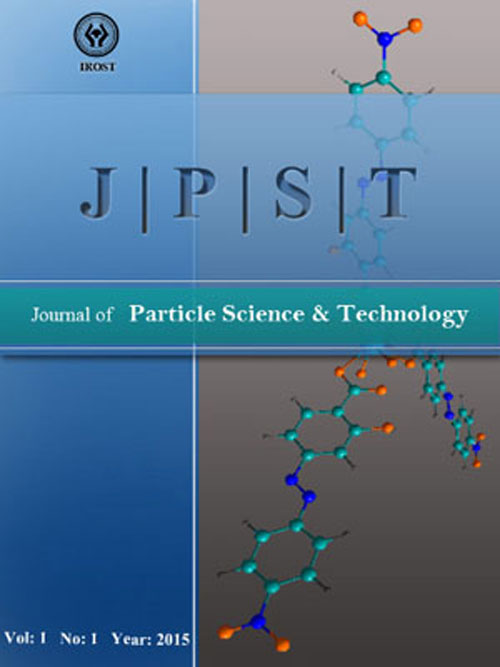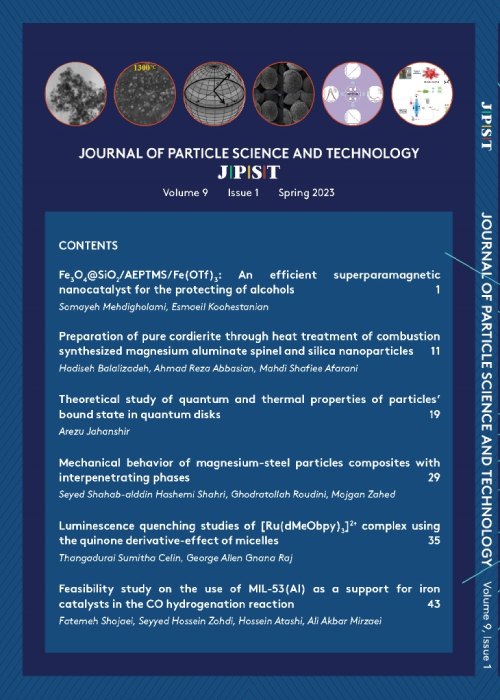فهرست مطالب

Journal of Particle Science and Technology
Volume:3 Issue: 1, Winter 2017
- تاریخ انتشار: 1396/02/30
- تعداد عناوین: 6
-
-
Pages 1-11Antibacterial properties of TiO2, ZnO as well as mixed TiO2-ZnO nanoparticles coated low density polyethylene films on Staphylococcus aureus PTCC1112 were investigated. Bactericidal efficiency of 0.5, 1 and 2 Wt% for TiO2 and ZnO nanoparticles and also 1 Wt% mixed TiO2-ZnO nanoparticles with TiO2:ZnO ratios of 25:75, 50:50 and 75:25 were tested under UV and fluorescent lights exposure at two different states: films alone (Direct effect) and fresh calf minced meat packed inside the films. ZnO nanoparticle showed good antibacterial properties against Staphylococcus aureus PTCC1112. Maximum CFU reduction of 99.59% and 97.07% were obtained using 2 and 1 Wt% ZnO nanoparticle coated LDPE film under UV light for films alone as well as 62.43% and 59.57% for fresh calf minced meat packed. The best antibacterial functionalities of 96.25% and 77.11% CFU reduction were recorded for 1 Wt% TiO2 nanoparticle coated LDPE films in the presence of UV light at direct contact with bacteria and fresh calf minced meat packed, respectively. In the case of mixed TiO2-ZnO, maximum CFU reductions of 98.37% and 97.84% were obtained using 50:50 ratio of TiO2: ZnO nanoparticles at the presence of UV light for direct effect and fresh calf minced meat packed, respectively. 2 Wt% ZnO nanoparticle as well as 1 Wt% mixed TiO2-ZnO nanoparticles in ratio of 50:50 coated LDPE films were identified as the best case to improve shelf life and prevent Staphylococcus aureus PTCC1112 growth in fresh calf minced meat.Keywords: Antibacterial agents, Fresh minced meat, LDPE films, nanoparticles, Staphylococcus aureus
-
Pages 13-24Shielding radiation from both x-rays and gamma-rays is important for personnel in medical fields e.g. interventional radiology, nuclear power stations, and other inspection facilities where radiation is involved. Lead is known for its effective shielding property against these high energy radiations, however heaviness and toxicity are its main drawback. In this study effectiveness of non-lead polymeric composite materials, which include high-atomic-number / or known barrier elements to absorb photons from the radiations was evaluated. High density polyethylene as matrix and powders of spherical W and lamellar MoS2 and B4C as particulate fillers with different loadings were melt mixed in an internal mixer, followed by compression molding in to sheet form. The goodness of dispersion was manifested via SEM and EDX images. Radiation attenuation capability of these compounds was examined with direct diagnostic x-ray exposure and compared with that of Pb. Dynamic rheology measurements were carried out to evaluate viscoelastic properties of the molten composite materials, necessary in shaping process operations. The mechanical and thermal properties were further investigated from the product performance point of view. Results demonstrated that the flexible composite sheet made with 45% (wt) tungsten provided comparable x-ray absorption to non-flexible lead sheet but much lighter in weight. Significant difference was observed between flow characteristics and yield strength of composite materials of highly loaded spherical metallic particles and lamellar particles of metallic compounds. The melt viscoelastic behavior of former was similar to that of neat matrix melt.Keywords: Radiation attenuation, Dispersion rheology, Mtallic compounds, Radiology, X-ray, Gamma-ray
-
Pages 25-32In this research, the feasibility of using mathematical modelling in the ball milling process has been evaluated to verify the hardness changes of an aluminium nanostructure. Considering the model of normal force displacement (NFD), the radius of elastic-plastic and normal displacement of two balls were computed by applying analytical modelling and coding in MATLAB. Properties of balls and aluminium powder were entered into the software as input data. The impact radius and then the hardness of powder were calculated accordingly. The changes of aluminium powder hardness resulting from the collision of two spherical balls during the synthesis of an aluminium nanostructure were analytically derived and compared with experimental data obtained from the literature. Calculation of results accuracy shows the model has a better agreement with the experimental data at the beginning than the results from Maurice et al. (R2= 0.68 in this model).This research innovation is to combine the NFD model with hardness formulation to calculate final hardness.Keywords: Ball milling, Modelling, Nanostructure, NFD model, Aluminium powder
-
Pages 33-40The aim of this study was to investigate the flexural behavior of engineered cementitious composites (ECCs) reinforced by cellulose pulp (CP) and cellulose microfibers (CMF). The reinforcements were obtained from chemical-mechanical treatments of Kraft paper and used in ECC mix design. Results showed that cement reinforced by CP exhibited a strain-hardening behavior in the three-point bending test, while CMF led to a brittle behavior in cement composites. Moreover, different hybrid combinations of polyvinyl alcohol (PVA) and CMF achieved quite a high strength while maintaining a high level of flexural toughness. A combination of 0.5 vol% CMF and 1.5 vol% PVA resulted in a significant increase in flexural toughness and a slight improvement in flexural strength. The properties of this hybrid composite were comparable with one containing 2 vol% of PVA fiber.Keywords: Cement, Engineered Cementitious Composite, Cellulose, Green composite, Flexural behavior
-
Pages 41-50Splashing of splat particles is one of the most important phenomena in industrial processes such as thermal spray coating. The data relative to the degree of splashing of splats sprayed with a normal angle are commonly characterized by the Weibull distribution function. In this present study, an effort has been made to show that the Burr distribution is better than the Weibull distribution for presenting the distribution of the degree of splashing. For this purpose, the Burr Type XII distribution and Weibull distribution are compared using different criteria. Furthermore, because of the great importance of statistical prediction of censored data in reducing costs and improving quality of the coating process, we consider different predictors of this data based on a progressively censored sample. For computing the prediction values we obtain the maximum likelihood estimates using the Expectation-Maximization (EM) algorithm. An important implication of the present study is that the Burr Type XII distribution more appropriately described the degree of splashing data. Therefore, the Burr Type XII can be used as an alternative distribution that adequately describes the splashing data and thereby predicts the censored data.Keywords: Burr Type XII, Censored Data, splat particle, Splashing, Progressively censoring, Thermal Spray
-
Pages 51-62The drying kinetics of hawthorn in a pilot-scale experimental fluidized bed dryer with and without vibration was investigated. The effect of operating parameters, such as vibration intensity, drying air flow rate, and temperature, on the drying rate and shrinkage of hawthorn was studied. The hawthorn fruit was dried at various drying air temperatures ranging from 40-70oC and drying air volume flow rates ranging from 22-30 m3/h with the vibration intensity ranging from 6.8 to 8.2 Hz. The entire drying process occurred in the falling rate period and no constant rate period was observed in the drying of hawthorn. Four mathematical drying models investigating the drying behavior of hawthorn were evaluated and then the experimental moisture data were fitted in these models. The quality of the models fitting was assessed using the coefficient of determination, chi-square and root mean square error. The logarithmic and Page models for drying rate and the Ratti and Vazquez models for shrinkage were found to be the most suitable for describing the drying and shrinkage curves of hawthorn. The results showed that the vibration intensity, drying air temperature and flow rate has no significant effect on the shrinkage of hawthorn. All mentioned parameters had a significant effect on the drying rate of hawthorn, but the effect of drying air temperature was considerably more compared to the other parameters. It was observed that shrinkage varies linearly with respect to moisture content, and the reduction in radial dimension of hawthorn samples was around 40% at the end of the drying process.Keywords: Vibro-Fluidized Bed Dryer, Hawthorn Drying, Shrinkage, Drying rate, Mathematical modelling


